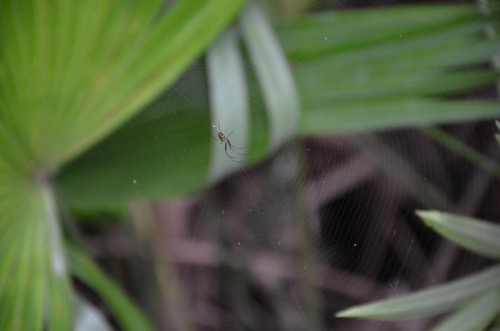BINGHAMTON UNIVERSITY - BINGHAMTON, NY - Would you want a spider web inside your ear? Probably not. But if you're able to put aside the creepy factor, new research from Binghamton University, State University of New York shows that fine fibers like spider silk actually improve the quality of microphones for hearing aids.
Binghamton University distinguished professor Ron Miles and graduate student Jian Zhou recently published a study in titled "Sensing fluctuating airflow with spider silk" that should lead to better microphones for hearing aids than traditional pressure-based systems.

New research from Binghamton University, State University of New York shows that fine fibers like spider silk actually improve the quality of microphones for hearing aids. Image courtesy of Jian Zhou.
Miles has done a number of studies looking at what we can learn from insects when it comes to hearing. He explained, "We use our eardrums, which pick up the direction of sound based on pressure, but most insects actually hear with their hairs." The spider silk is able to pick up the velocity of the air instead of the pressure of the air.
Mosquitos, flies and spiders all have fine hairs on their bodies that move with the sounds waves traveling through the air. Miles wanted to recreate this type of hearing inside a microphone.
Their microphone improves the directional sensing across a wide variety of frequencies that are often too quiet for microphones to pick up on. For someone with a hearing aid, that means being able to cancel out background noise when having a conversation in a crowded area. The same concept could be applied to the microphone inside cell phones.
Spider silk is thin enough that it also can move with the air when hit by soundwaves. "This can even happen with infrasound at frequencies as low as 3 hertz," said Miles. Sound at that frequency is typically inaccessible. It'd be equivalent to hearing the tectonic plates moving in an earthquake.
The study used spider silk, but Miles explained that any fiber that is thin enough could be used in the same way.
While the spider silk picks up the direction of airflow with great accuracy, that information has to be translated into an electronic signal to be of use.
"We coated the spider silk with gold and put it in a magnetic field to obtain an electronic signal," said Miles. "It's actually a fairly simple way to make an extremely effective microphone that has better directional capabilities across a wide range of frequencies."
The study is a game-changer for microphones but may also tell us something unique about spiders, said Miles. He and Zhou speculate that because spider silk is so good at sensing air flow, it's possible spiders can hear through their own web on top of what they are already known to hear through the small hairs on their bodies.
Source: https://www.eurekalert.org/pub_releases/2017-10/bu-ssc102617.php

